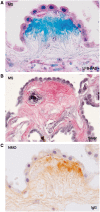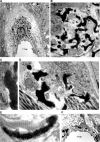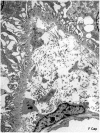Fibrosis of the Choroid Plexus Filtration Membrane
- PMID: 27444353
- PMCID: PMC5015658
- DOI: 10.1093/jnen/nlw061
Fibrosis of the Choroid Plexus Filtration Membrane
Abstract
We report a previously undescribed inflammatory lesion consisting of deposition of activated complement (C3d and C9neo) in association with major histocompatibility complex type II (MHC2)-positive activated microglia in choroid plexus villi exhibiting classical fibrous thickening of the pericapillary filtration membrane. The proportion of villi affected ranged from 5% to 90% in 56 adult subjects with diseases of the CNS and 11 subjects with no preexisting disease of the CNS. In 3 of the 4 children studied, 2% or less of examined villi showed stromal thickening, complement deposition, and the presence of MHC2-positive microglia; in adults, the proportion of villi affected increased with age. Other features of the lesion included loss of capillaries and failure by macrophages to clear extracellular particulate electron-dense material by clathrin-mediated phagocytosis. This choroid plexus lesion may relate pathogenetically to age-related macular degeneration and to Alzheimer disease, 2 other conditions with no known risk factors other than increasing age. All 3 conditions are characterized by the presence of damaged capillaries, inflammatory extracellular aggregates of mixed molecular composition and defective clearance of the deposits by macrophages.
Keywords: Alzheimer disease; Choroid plexus; Complement; Macular degeneration; Multiple sclerosis..
© 2016 Oxford University Press OR American Association of Neuropathologists.
Figures















References
-
- Parratt JD, Prineas JW. Neuromyelitis optica: a demyelinating disease characterized by acute destruction and regeneration of perivascular astrocytes. Mult Scler 2010;16:1156–72 - PubMed
-
- Misu T, Fujihara K, Kakita A, et al. Loss of aquaporin 4 in lesions of neuromyelitis optica: distinction from multiple sclerosis. Brain 2007;130:1224–34 - PubMed
-
- Roemer SF, Parisi JE, Lennon VA, et al. Pattern-specific loss of aquaporin-4 immunoreactivity distinguishes neuromyelitis optica from multiple sclerosis. Brain 2007;130:1194–205 - PubMed
-
- Prineas JW. Multiple sclerosis: presence of lymphatic capillaries and lymphoid tissue in the brain and spinal cord. Science 1979;203:1123–5 - PubMed
-
- Adams RD, Oksche A, Haymaker W. Meninges, choroid plexuses, ependyma and their reactions. Part 2: Age-related changes and pathology In: Haymaker W, Adams RD, eds. Histology and Histopathology of the Nervous System. Springfield, IL: Charles C. Thomas; 1982:641–713
Publication types
MeSH terms
LinkOut - more resources
Full Text Sources
Other Literature Sources

